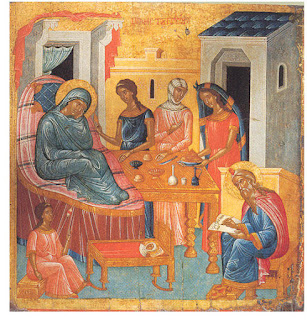John the
Forerunner is the last prophet of the Old Testament, who revealed Jesus Christ
to his chosen people. His other name “the Baptist” highlights his mission to
baptize Jesus Christ. The range of sources includes the facts about his life:
the four canonical Gospels, the book “Acts of the Apostles”, the works of
Josephus, and different early Christian apocrypha.
According
to Gospel of Luke, John
the Baptist was born in the family of pious
Zachary (of the course of Abia) and Elisabeth (of the daughters of Aaron)
(Luke, 1:5). The parents were rather old and childless. Archangel Gabriel
showed up to Zachary and foretold the birth of the Forerunner. When Zachary
doubted that prophecy, he became mute (Luke, 1:22) till the moment he
proclaimed the name of the child. (Luke, 1:63, 64) John the Baptist was born in
the city of Juda (1:39).
For the
first time the composition “The Birth of John the Baptist” was discovered on
the murals in the Church of Sofia in Orkhida (mid. XI cent.) and different
miniature paintings of the second part of the XI century. The icon of the Birth
of John the Baptist became the central episode in the cycle images in his
childhood in the middle and late Byzantine era. The main part of composition -
the bed and Elisabeth lying on it – goes back to the iconography of “the
Nativity”, which was taken by the Christians from the ancient typological
cycles of the late antiquity era. When the traditional scheme was being adapted
to the cycle of the Forerunner, an additional episode named “Zachary declares
the name of John” was included in it. Its iconography is known since the IV
century and for the first time it was used in the sculpture of the Lateran
sarcophagus (IV c., Lateran museum, Rome).
In some extended life
cycles this episode could be painted in a separate field: there is one on the
Sinaic icon “Saint John the Baptist and his Life in 15 episodes” (the beginning
of the XIII century). Another example is the icon of “Saint John the Baptist
and his Life in 16 episodes” from the village Nyonoksa in Archangelsk region.
In the XIV century a new
tendency of “Paleolog art” appeared. According to it, some everyday
elements were included into the iconography. That is why a table with
food near the Elisabeth’s bed, as well as the episode “Baby-rocking”, appeared
in the composition of “The Birth of John the Baptist” (the same elements were
included into the composition of the icon “The Birth of the Mother of God”).
In
the XVI-XVII centuries, “The Birth of John the Baptist” became a necessary
episode of all the life cycles of the saint. But there were some festal icons
in this theme too: the icon of Novgorod from the Kopsky Monastery (the first
quarter of the XVI century); two double-sided icons from the Tretyakov Gallery
(second part of the XVI century); the icons from the collection of N. P.
Likhachev (the XVI century). Despite the fact the composition of the Birth is a
permanent episode of all the life cycle icons of John the Baptist, it is rarely
placed in the center of icons, for example in case of the icon “The Birth and
Life of John the Baptist” from the Pokrovsky Cathedral on the Rogozhskoye
Cemetery in Moscow (the first third of the XVI century).
The saint
is honored several times a year and each date is connected with a
particular event:
·
July 7 (June 24) – the Birth of St. John the
Baptist;
·
September 11 (August 29) – the Beheading of St.
John the Baptist;
·
October 6 (September 23) – the Conception of St.
John the Baptist;
·
January 20 (January 7) – the Synaxis of St. John
the Baptist;
·
March 9 (February 24) and June 7 (May 25) – the
Finding of the Head of John the Baptist.




















CONVERSATION